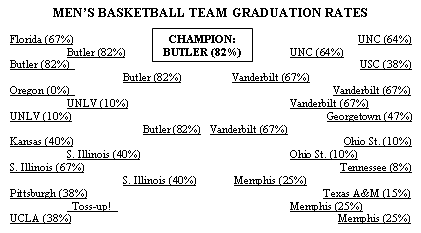Who Will Win the NCAA...Graduation Rate Tournament?
Blog Post
March 26, 2007
The NCAA Tournament, now narrowed to a Final Four group of colleges, is garnering more attention than ever. The Final Four, and before them the Sweet Sixteen, have been praised by the press and revered by the public for their success. Hey Dick Vitale and all of you crazies out there (myself included): is this really a praiseworthy measure of achievement?
Our colleague at Education Sector, Kevin Carey, questions America's basketball reverence in an excellent blog post that compares the graduation rates of teams in the tournament. As Carey points out, the graduation rates at many of NCAA schools are appalling, particularly when disaggregated by race. We're placing schools on a pedestal that cant even graduate half of their students.
Following Careys example (and using this handy graduation rate data tool from the Education Trust), we decided to play out the Sweet Sixteen based on graduation rates. First, we did so by overall graduation rate (higher rate=victory). Then, we did so according to the disparity in graduation rates between black and white men schoolwide (lower disparity=victory).


Check out the different Final Fours. While some teams perform well in the overall rate bracket, they lose in the first round of the disaggregated bracket. Georgetown, the champion of the overall rate bracket, is in the bottom five for teams with the worst disparities between white and black males. The number one and two seeds would not dominate in our contest. Props to Vanderbilt and Butler, the finalists in the disaggregated bracket, for graduating a higher percentage of black men than white men.
Carey also brings up another important point on student athletes in his blog. While players like Greg Oden, Kevin Durant, and Brandan Wright probably wont need a bachelor's degree in the future, they are the exceptions. How well are colleges supporting the rest of the non-NBA bound players on their basketball teams?
Very, very poorly. The NCAA is required to collect and publish the graduation rates of its student athletes who receive athletic scholarships. The best, most recent data comes from a four-class aggregate of classes that entered school between 1996 and 1999. And this data shows that the Sweet Sixteen are failing their basketball teams. On average, the Sweet Sixteen graduated only 38.5% of their mens basketball players within six years of initial enrollment. We played out the tournament based on basketball team graduation rates, and this bracket, similar to the disaggregated contest, would be upset city.

The worst part is that there has been little pressure on these schools to remedy this situation. The NCAA's data does not show much improvement over time. The Division I male basketball player average graduation rate hit an all-time low in 2001, when only 40% of the class that matriculated in 1994-95 had graduated within six years. Since then, the average graduation rate has only slightly increased to 43% in 2004 and 44% in 2005.
The NCAA may finally take action. It recently convened a task force on athlete admissions that is reviewing the "special admit" process (i.e. the lowering of academic standards for athletes). The commission is discussing placing limits on under-qualified special admits. This is an important conversation, but the NCAA must also consider how schools are assisting their athletes academically once on campus. Colleges aren't going to stop completely lowering their standards for athletes. But they can do more to ensure that their athletes have the tools to graduate.
Thanks to Kevin Carey for bringing this problem to light. Time for the NCAA, if not Congress, to do something about it.